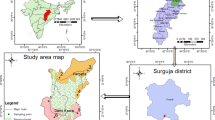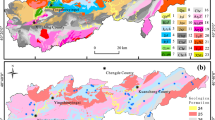Abstract
XPS and AES depth composition profile studies were carried on to understand chemical components of (100) surfaces for Chengde hypersthene from Hebei Province, China, and Bamble enstatite from Norway. Also, to understand the microtopography of them the AFM observation was carried on. There are obvious differences between chemical components of (100) surface and those of mineral inner. Compared with inner mineral Si4+ proportion in total cations has no distinguished variation, whereas Ca2+ and Al3+ proportions increase respectively, and Mg2+ proportion decreases. AES depth composition profile of 2000s shows that at a depth of 70 nm the atomic concentrations (%) for each element (except Si in Chengde hypersthene) slightly go up and down, but the average values have no obvious change. On the profile, the atomic concentrations (%) of Al and Si for Chengde hypersthene present a compensated relationship. Obviously, the Si and Al must have the relationship of isomorphic replacement on the (100) surface. The image of AFM shows that there is hillock growth on the (100) surface in the layered form of the polygon with 0 to several hundreds nm in thickness. The growth is a sort of secondary phyllosilicate minerals. The observation of the above-mentioned phenomenon and the recognition on the above regularities are benefit for understanding of the mechanism for weathering and water-rock reactions.
Similar content being viewed by others
References
Schott, J, Robert, A. B, Sjöberg, L., Mechanism of pyroxene and amphibole weathering-I, Experimental studies of iron-free minerals, Geochim. Cosmichim. Acta, 1981, 45: 2123–2135.
Schott, J, Robert, A. B., X-ray photoelectron studies of the mechanism of iron silicate dissolution during weathering, Geochim. Cosmichim. Acta, 1983, 45: 2233–2240.
Mogk, Q. W, Locke, W. W. III., Application of auger eletroscopy (AES) to naturally weathered hornblende, Geochim. Cosmichim. Acta, 1988, 52: 2537–2542.
Eggleton, R. A, Boland, J. N., weathering of enstatite to talc through a sequence of transitional phases, Clays and Clay Minerals, 1982, 30: 11–20.
Kawano, M, Tomita, K., TEM-EDX study of weathered layers on the surface of volcanic glass, bytownite, and hypersthene in volcanic ash from Sakurajima volcano, Japan, Amer. Mineral., 2001, 86: 284–292.
Deer, W. A, Howei, R. A, Zussman, J, Rock-Forming Minerals, VLongmans, Greenand Co LTD., 1962, 3: 122–123.
Veblen, D. R, Buseck, P. R., Microstruetures and reaction mechanisms in biopyriboles, Amer. Mineral., 1980, 65: 599–623.
Veblen, D. R., Non-classical pyriboles and polysomatic reaction, Reviews of Mineralogy, 1981, 9A: 223–230.
Nakajima, Y, Ribbe, P. H., Texture and structure interpretation of alteration of pyroxene to other biopyriboles, Contr. Mineral. Petrol., 1981, 78: 230–239.
Author information
Authors and Affiliations
Corresponding author
About this article
Cite this article
Xue, J., Pan, Y., Luo, G. et al. Chemical components and microtopography of (100) surface for orthopyroxene. Chin.Sci.Bull. 48, 931–934 (2003). https://doi.org/10.1007/BF03325678
Received:
Published:
Issue Date:
DOI: https://doi.org/10.1007/BF03325678




